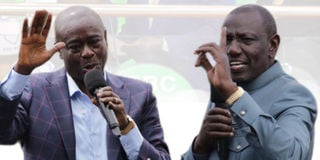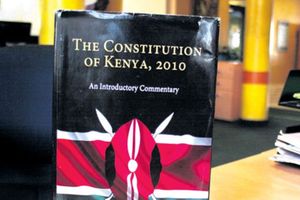
President William Ruto and his deputy Rigathi Gachagua.
When he was vice president, President William Ruto’s relationship with President Uhuru Kenyatta in their last term (2018-2022) disintegrated badly. The main issue was Mr Kenyatta’s preference for erstwhile rival, former Prime Minister Raila Odinga, as his successor in the 2022 election.
In the end, Mr Ruto prevailed and became president. Now he has a “Ruto situation” with his Deputy President Rigathi Gachagua, in a messy intra-ruling Kenya Kwanza party knife fight. The main reason for the animus seems to be the calculations around President Ruto’s re-election in 2027. This time, though, the break has come in the first, not second, term.
There is a pattern here, and indeed historically relations between Kenyan presidents and their deputies have mostly been turbulent. In the case of Kenya’s first vice president Jaramogi Oginga, who resigned in 1966 after ideological disagreements with President Jomo Kenyatta, he was jailed three years later. President Daniel arap Moi fell out with and changed his deputies five times faster than he changed his rungu (baton).
So, this dominant pattern suggests two things. First, there is something about Kenya itself, which makes it incongruent with Western-derived models of government. Second, the problem is not the players, but the game.
2010 Constitution
Kenya suffered a moment of hubris during the making of the 2010 Constitution, which established the norm of having a running mate for a presidential candidate, and the idea that the deputy president was a co-president. In Uhuru’s first term, Ruto was a co-president, if not in fact, at least in the optics.
This American model united disparate Kenyan political forces. The loose left and civil society saw in it another foil against an imperial presidency. The social media digital era Kenyan nationalists saw it as a good national branding, and talked a lot (inaccurately) about how “it set Kenya apart from other African countries as the one with the US model”. The Kenyan right, which tends to be Anglophile and Americophile, were delighted they saw it as a superior design.
In practice, under the 2010 Constitution, the choice of running mate and deputy president became a narrow and crude election-winning tactic and little more than the equivalent of a weekend fling. It never evolved into a governing strategy, let alone a transition vehicle.
Just like most women and men rarely go on to marry their partner for fleeting weekends, Kenyan presidents tend to discover shortly after they are sworn in, that their deputies aren’t the politicians they wanted to live happily ever after with.
Kenya is becoming a pluralistic democracy, but it is not there yet. Unfortunately, like in most of Africa, a chief is still the chief, and the notion of a president being only just the first among equals, with a deputy who is an equal shareholder, is a piece of fancifulness that does little more than water Kenyan exceptionalism. It only feeds government instability.
Autonomy of institutions
The best way you control the likely excesses of the king is not by installing an assistant king in the palace. It is by bulking up the power and autonomy of institutions outside the palace, as the Kenya 2010 Constitution tried to do with the Judiciary and Parliament, but didn’t go far enough. The ultimate counter though, is political because too often, the Judiciary and Parliament succumb to the seduction of the king.
Power behaves mostly when the political cost of bad conduct and abuse of office is very high (an election loss, imprisonment for corruption, banishment, and so forth). And you get that through the ability to deliver such punishments through political organising.
Ceremonial office
The reforms that will deliver these, can only be entrenched in a future constitutional reform. When Kenya gets there, it should consider a couple of things: Get rid of the office of the deputy president. Then establish a Prime Minister who is ceremonial, and does only a few things like receiving foreign leaders at the airport, leading national efforts for disaster relief, and representing the president at funerals when the Big Man/Woman has a headache or hangover and can’t show up in person. Or turn the president into a ceremonial office, like in several European countries, and have the Prime Minister as the fellow with the power to crack the whip.
That means there is no president-in-waiting, something that Kenya, except for the period when Moody Awori was Mwai Kibaki’s VP, has a problem managing. The Awori case also suggests that the ceremonial president or premier should be a well-retired figure, who no longer has the lungs to run a hard six-month campaign to be president, should he or she suddenly get ideas about making a bid for the job.
For the role of DP, Kenya might currently have an outline of a solution in the shape of Musalia Mudavadi, who is the Prime Cabinet Secretary, a first among Cabinet secretaries/ministers – appointed by the president. It helps too, of course, if like Mudavadi, the holder of the officer carefully chooses their words, and keeps their head down. Otherwise, to repeat, in these parts, a chief is still a chief – sadly.
The author is a journalist, writer, and curator of the "Wall of Great Africans". Twitter@cobbo3













